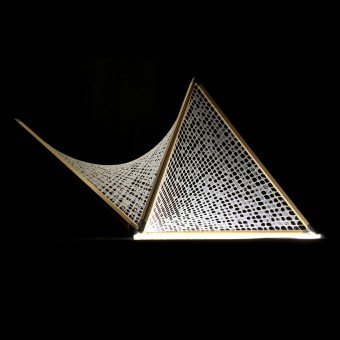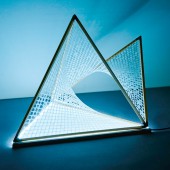Hineri Object Lighting by Yukari Sato |
Home > Winners > #77548 |
 |
|
||||
| DESIGN DETAILS | |||||
| DESIGN NAME: Hineri PRIMARY FUNCTION: Object Lighting INSPIRATION: I started making paper by hand when I questioned about mass production and consumerism. Nowadays, as mechanization accelerates in the manufacturing industry, we have been experiencing the loss of craftsmanship. However, I believe we can combine the benefits of traditional techniques with the latest technologies, and pass on the classic artistry and materials to future generations through creations that fit our modern lives. UNIQUE PROPERTIES / PROJECT DESCRIPTION: For this work, paper threads were attached to a delicate wooden frame, made by a local craftsman who has the traditional skills, and produces items for shrines and temples, and the joint parts are a titanium outputted by the 3D printer. Washi was thinly applied in layers to this many times to make it translucency. The fiber spreads randomly on the hyperbolic paraboloid strings, expressing the ambiguity of humans and our ambiguous coexistence with technology. OPERATION / FLOW / INTERACTION: Developed new style of Japanese washi paper which do not block the flow of air, share the space with the Japanese sensitivity of "ambiguously&qu PROJECT DURATION AND LOCATION: The project started in June 2016 in Ehime and finished in March 2017. It was exhibited in Tokyo at LEXUS NEW TAKUMI PROJECT in January 2017. FITS BEST INTO CATEGORY: Fine Arts and Art Installation Design |
PRODUCTION / REALIZATION TECHNOLOGY: The production of Hineri starts with building the delicate wooden frame. A smooth surface is created with thin lines of threads and the papermaking process is repeated many times by dipping it into the water tank containing special bark fiber of mulberry which was developed with a research institution to heighten the dehumidifying and deodorizing functions. Clear groundwater called Kannon sui is used for my washi making, and was selected as one of the hundred exquisite waters of Japan. SPECIFICATIONS / TECHNICAL PROPERTIES: Materials and techniques used Materials: Paper mulberry, nylon, cypress Techniques: Washi-suki/paper-mak TAGS: washi , paper , 3d , lighting , wood RESEARCH ABSTRACT: Hineri, or twist, is a Japanese term that expresses a spirally bent shape. Metaphorically, it can also mean witty, humorous, creativity, ingenious, or intellectual. The artwork changes its look by being placed in various ways on the triangular LED light guide plate stage. It symbolizes that the world is multidimensional and ambiguous, and encourages three-dimensional perception. We tried to draw a future in which we interact through intelligence such as humor, creativity, and ingenuity. CHALLENGE: Incorporated 3D technology and digital fabrication into the handicraft production process, with the challenge to make full use of each technique. In this project, we considered the relationship between manual work and incorporation of the latest technology, while evaluating how the use of latest technology can promote the improvement of human creativity instead of taking away work from people as often expected. ADDED DATE: 2019-02-19 16:18:24 TEAM MEMBERS (2) : Takashi Terada and IMAGE CREDITS: Yukari Sato, 2018. |
||||
| Visit the following page to learn more: http://www.requ.jp/ | |||||
| AWARD DETAILS | |
 |
Hineri Object Lighting by Yukari Sato is Winner in Fine Arts and Art Installation Design Category, 2018 - 2019.· Read the interview with designer Yukari Sato for design Hineri here.· Press Members: Login or Register to request an exclusive interview with Yukari Sato. · Click here to register inorder to view the profile and other works by Yukari Sato. |
| SOCIAL |
| + Add to Likes / Favorites | Send to My Email | Comment | Testimonials | View Press-Release | Press Kit |
Did you like Yukari Sato's Fine Art Design?
You will most likely enjoy other award winning fine art design as well.
Click here to view more Award Winning Fine Art Design.








